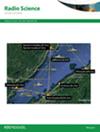Manually reconfigurable reflecting surface (MRRS) by detached rotatable unit cells for 5G FR2 radio coverage at low-cost fabrication
IF 1.5
4区 地球科学
Q3 ASTRONOMY & ASTROPHYSICS
引用次数: 0
Abstract
A manually reconfigurable reflecting surface (MRRS) formed by detached rotatable unit cells is proposed to enhance the signal strengths in 5G FR2 radio coverage. The forming unit cell is a conductor-backed circular-patch-based element implemented with two anti-symmetric arms manually extendable to adjust the relative reflection phases. The proposed MRRS is structured in a two-substrate configuration on a ground plane. The first dielectric substrate accommodates all identical and detachable elements manually rotated to reconfigure the MRRS's reflection phases. In contrast, the second substrate's top face imprints the two arms' footprints. The reflection phases are altered by adjusting the overlapped arms' lengths between the two dielectric substrates. This allows one to redirect and reconfigure the scattering fields' patterns in the desired coverage area. Based on the novel configuration of unit cells, the cross-polarization of the reflected waves can be significantly reduced with the interleaved and mirrored cell constellation. A 21 × 21-element MRRS in the format of reflectarray is designed at 28 GHz to validate the effectiveness through experimental measurements. The measured results show 4% 1 dB and 7% 3 dB gain bandwidths. The maximum gain at 28 GHz is 25.6 dB, and the aperture efficiency is approximately 37.8%.通过分离的可旋转单元格手动重新配置反射表面(MRRS),用于低成本制造的5G FR2无线电覆盖
提出了一种由分离的可旋转单元组成的手动可重构反射面(MRRS),以增强5G FR2无线电覆盖中的信号强度。形成单元电池是一个基于导体的圆形贴片的元件,实现了两个可手动扩展的反对称臂,以调整相对反射相位。所提出的MRRS结构是在一个地平面上的双基板结构。第一个介质衬底容纳所有相同的和可拆卸的元件,手动旋转以重新配置MRRS的反射相位。相比之下,第二基材的上表面印着两个手臂的足迹。通过调整两个介质基板之间重叠臂的长度来改变反射相位。这允许人们在期望的覆盖区域中重定向和重新配置散射场的模式。基于这种新型的单元格结构,交错镜像的单元格星座可以显著降低反射波的交叉极化。在28ghz波段设计了21 × 21元的反射式MRRS,并通过实验测量验证了该方法的有效性。测量结果显示增益带宽为4% 1 dB和7% 3 dB。28ghz时的最大增益为25.6 dB,孔径效率约为37.8%。
本文章由计算机程序翻译,如有差异,请以英文原文为准。
求助全文
约1分钟内获得全文
求助全文
来源期刊

Radio Science
工程技术-地球化学与地球物理
CiteScore
3.30
自引率
12.50%
发文量
112
审稿时长
1 months
期刊介绍:
Radio Science (RDS) publishes original scientific contributions on radio-frequency electromagnetic-propagation and its applications. Contributions covering measurement, modelling, prediction and forecasting techniques pertinent to fields and waves - including antennas, signals and systems, the terrestrial and space environment and radio propagation problems in radio astronomy - are welcome. Contributions may address propagation through, interaction with, and remote sensing of structures, geophysical media, plasmas, and materials, as well as the application of radio frequency electromagnetic techniques to remote sensing of the Earth and other bodies in the solar system.
 求助内容:
求助内容: 应助结果提醒方式:
应助结果提醒方式:


